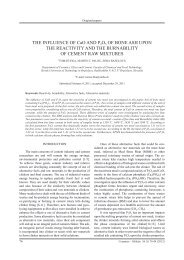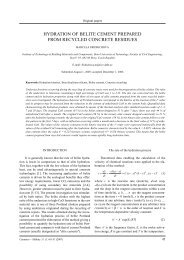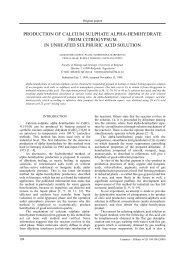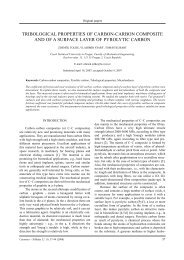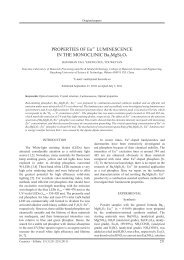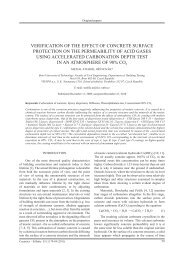M2O3 = Al2O3, Ga2O3, Sc2O3, La2O3, Bi2O3 - Ceramics-Silikaty
M2O3 = Al2O3, Ga2O3, Sc2O3, La2O3, Bi2O3 - Ceramics-Silikaty
M2O3 = Al2O3, Ga2O3, Sc2O3, La2O3, Bi2O3 - Ceramics-Silikaty
You also want an ePaper? Increase the reach of your titles
YUMPU automatically turns print PDFs into web optimized ePapers that Google loves.
Figure 1. Boundaries between one- and two-phase glass regions<br />
in the systems TeO 2-B 2O 3-M 2O 3: M 2O 3= (1) Al 2O 3; (2) Ga 2O 3;<br />
(3) Sc 2O 3; (4) La 2O 3; (5) Bi 2O 3.<br />
The results of TEM observations show the<br />
influence of the third component on the immiscibility<br />
tendency in different tellurite-borate glasses. In our<br />
previous works [5 - 8], the pronounced trend for cluster<br />
formation in slowly cooled pure vitreous B 2O 3 (v-B 2O 3)<br />
has been discussed. The presence of nano-scale<br />
heterogeneities in v-B 2O 3 ranging in sizes between 1.5 -<br />
2 nm was experimentally established by TEM data<br />
[6, 7]. According to the classification of Zarzycki [9]<br />
and Porai-Koshits [10], they were associated with the<br />
thermal density fluctuations. By means of MM<br />
computer simulation, we made an attempt to model the<br />
cluster formation in borate network at the presence of<br />
BO 3-groups and B 3O 6-boroxol rings [5, 7, 8]. The<br />
addition of TeO 2, containing mainly TeO 3-groups,<br />
stimulates the clustering at micro-scale level [5, 7] and<br />
leads to appearance of metastable phase separation. In<br />
this sense, the role of the third component should be<br />
assigned to its influence on the formation of different<br />
borate or tellurite complexes.<br />
Some typical IR-spectra of chosen compositions in<br />
binary and three component systems are shown in<br />
figures 5 and 6. Their interpretation is based on IR data<br />
analysis of borate glasses [11 - 15]. According to the<br />
obtained IR-spectra the B 2O 3 participates as BO 3- (1380<br />
and 1240 cm -1 ) and BO 4-groups (900 cm -1 ) in the<br />
network of the binary tellurite glass, in spite the small<br />
B 2O 3 amount in the composition (figure 5 - 1). Similar<br />
spectra are obtained when La 2O 3 is added to TeO 2-B 2O 3<br />
glass, but the intensity of the band at 1325 cm -1<br />
increases at the expense of the band at 1215 cm -1 ,<br />
leading to an increase in the tendency for formation of<br />
superstructural units containing BO 3- and BO 4-groups<br />
(figure 5 - 2). This trend is developed (1380, 1050 and<br />
940 cm -1 ) for composition with higher B 2O 3 content<br />
E. Kashchieva, M. Pankova, Y. Dimitriev<br />
Figure 2. Immiscibility droplets and micro-aggregates in onephase<br />
glass with composition 70TeO 2,20B 2O 3,10Bi 2O 3<br />
(mol.%).<br />
Figure 3. B 2O 3-enriched immiscibility droplets in the low layer<br />
of two-phase glass with composition 20TeO 2,70B 2O 3,10 Ga 2O 3<br />
(mol.%).<br />
Figure 4. Microcrystals dispersed in amorphous matrix of glass<br />
with composition 50TeO 2,30B 2O 3,20Al 2O 3 (mol.%).<br />
112 <strong>Ceramics</strong> − Silikáty 45 (3) 111-114 (2001)



